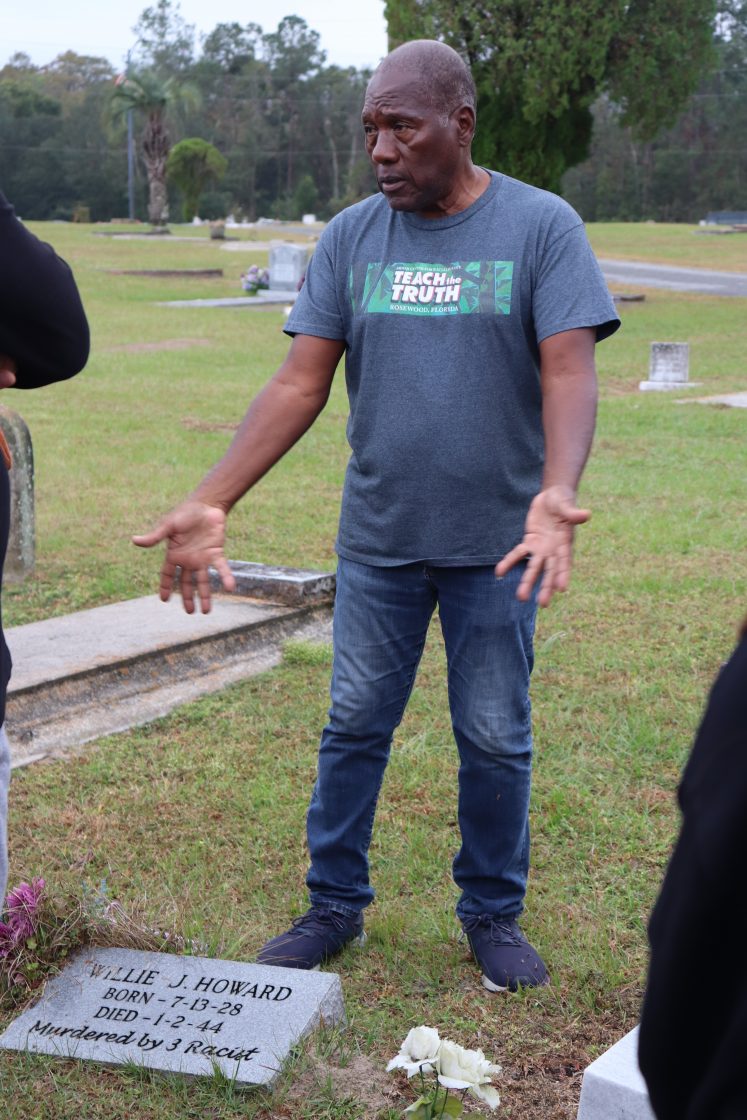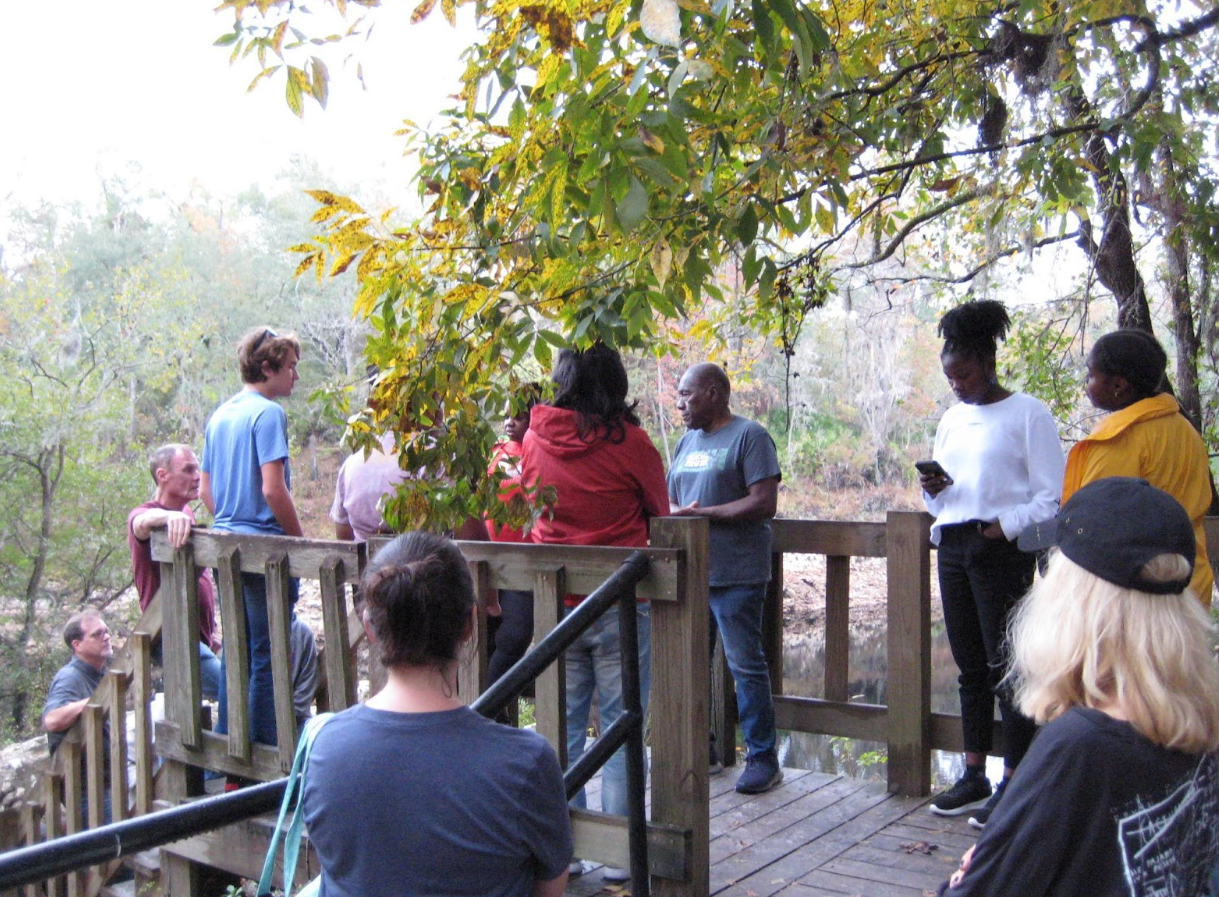On Nov. 11 students, staff and faculty from New College, University of Florida (UF) and community members from across the state joined Dr. Marvin Dunn, professor emeritus from the Department of Psychology at Florida International University (FIU) for an overnight Teach the Truth Tour. The truths the tour sought to teach, were “about the underbelly of Florida. The part of Florida’s history that’s covered up… and sometimes you have to turn the gator over and look at what’s there,” Dunn said.
Erik Wallenberg, Historical Consultant with the Miami Center for Racial Justice (MCRJ), a non-profit Dunn was integral in founding, worked alongside Dunn and other MCRJ staff to plan the logistics of the November tour, which included visits to Live Oak, Newberry, the Olustee Battlefield and Rosewood. Upperclassmen may recognize Wallenberg as a former Visiting Assistant Professor of History who hosted Dunn as a guest speaker in a class earlier this year. As of June 2023, Wallenberg began working with MCRJ to scale up the tours and get students, staff and faculty “plugged in” with the programming.
“One of the first colleges we wanted to approach was New College,” Wallenberg stated in a telephone interview. “Given my history there, given the faculty and students that we know, there were a number of faculty and students that were eager to jump on board to attend the Teach the Truth Tour.”
Teach the Truth Tours did not begin with New College, though. The tours started in early 2023, with a focus on engaging high school students and community members across the state, later including higher education institutions such as Stetson University.
“All the places on the Teach the Truth Tour were pretty close to where I grew up and lived forever,” second-year Molly Branham told a Catalyst reporter. “I was interested to see it and hear about racial violence and its history and it was a really cool experience but it changed my perception of places I’m used to. We go to a place and I’m like ‘I’m familiar with this, I know what it looks like, I know who lives here’ but it’s a different side of the story that I never got to see.”
Tour participants walked the same ground as those who were made to flee their homes in the historic Black community of Rosewood in what is now known as the Rosewood massacre. Dunn and a partner purchased a portion of land in Rosewood to preserve its history; they stand as the only Black landowners in Rosewood to this day. Along with local historians at their many stops, Dunn recounted the harrowing lived experiences of the Black community in Rosewood, preserved through oral histories, physical landmarks and tours.
“In my view, the best way to preserve them [Black histories] is by having people have a direct experience by going to the bloody ground, going to sacred places that we now revere because these things [racial violence] happened there,” Dunn explained. “So it’s a direct learning experience by having people not just read about it, but go to where it happened, and feel it as well.”
Professor of Anthropology and tour participant Maria Vesperi told the Catalyst about one of the many stories Dunn shared and the impact this had on the group.
“An especially moving thing, the site where a young man named Willie James Howard lived. He was 15 years old and he worked at a five-and-dime store. We drove by the store and we drove by his house,” Vesperi said. “This young man gave Christmas cards to the kids he worked with; he was the only Black high school student working there. One of the girls took offense and so he wrote a letter. Her father got hold of the letter, and on the basis of that, a group of men went to his house and took him. [They] went to his dad’s workplace and picked him up—we drove by that too—then drove to a park on the Suwannee River. He had his hands and feet tied together and was forced to jump into the river and drowned.

“The thing about that and all the other stories Dr. Dunn showed us and told us about is that he explained them in such a compelling way that people felt empowered by the knowledge they were gaining about the history and what really happened,” Vesperi said. She encouraged readers to visit the site dunnhistory.com, which contains a wealth of historical information and media resources, including a documentary Dunn made about the 1944 murder of Willie James Howard.
The sentiment of empowerment, changing perceptions and transformative experiences was apparent in each interview. Despite the range of worldly experience each student, faculty and community member brought with them to the tour, participants left with a new breadth of knowledge, and a copy of Dunn’s book A History of Florida Through Black Eyes.
“To see the level of violence and to learn that Florida, per capita, had the highest number of lynchings of any other state in the country was startling,” Wallenberg said. “There’s certainly some things I learned that I didn’t know and certainly the individual stories that Dr. Dunn tells in his book and on the tour of racial violence and of the people who resisted it and how they fought back against racial violence, it was really inspiring. But it’s also a common story across the country so, in some ways, Florida fits right into the national narrative. It has its particular histories but it’s not all that different than other states in the US. Sadly.”
Students on the tour expressed their reasoning for signing up to physically experience Florida’s history.
“I decided to take the trip because I’ve lived in Florida all my life without knowing Black history, specifically in Florida, so not only learning about Black history, but going to the places in which they took place was incredibly transformative and very moving,” second-year Lianna Paton described. “It stays with you. I think about the places we visited all the time and just the visuals, it’s hard history and it’s not fun at all but it’s really important and it’s work that has to be done.”
“The opportunity seemed critically important and once in a lifetime, so I did not want to pass up the opportunity,” second-year Maxwell Parsons said. “A highlight of the trip was the visit to one of the graveyards, where there are unmarked graves in the brush behind the cemetery. It was one of the more sobering destinations on the tour.”
For those interested in participating in future tours, there will be more to come in 2024. MCRJ underwrites the costs of bus travel and overnight hotel accommodations for each tour, and those interested can visit this link to become part of the process and growth at MCRJ, or to donate to support future tours and MCRJ initiatives.

